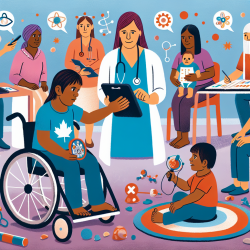Key Findings
The literature review identified several factors impacting childhood disability in Indigenous communities:
- Higher Prevalence: Indigenous children have higher rates of disability compared to non-Indigenous children, with significant disparities in areas such as hearing loss due to otitis media.
- Limited Data: There is a lack of comprehensive data on the prevalence and types of disabilities among Indigenous children, particularly in urban areas.
- Barriers to Access: Indigenous children face multiple barriers to accessing disability services, including cultural attitudes, remoteness, and systemic issues.
- Need for Culturally Appropriate Interventions: Standard assessments and interventions are often not culturally relevant, necessitating the development of tailored approaches.
Recommendations for Practitioners
To address these issues and improve outcomes for Indigenous children with disabilities, practitioners can implement the following strategies:
- Regular Screening: Implement regular hearing and developmental screenings in schools and communities to identify issues early. Ensure these screenings are culturally appropriate and accessible.
- Collaborative Approaches: Work collaboratively with Indigenous health workers, educators, and families to develop and deliver interventions. This can help build trust and ensure that interventions are culturally sensitive and effective.
- Professional Development: Engage in ongoing cultural competence training to better understand the unique needs and perspectives of Indigenous communities. This training should include information on effective communication strategies and culturally relevant assessment tools.
- Advocacy and Policy Change: Advocate for policies that address the social determinants of health and promote equitable access to disability services for Indigenous children. This includes pushing for more funding and resources for Indigenous-led health and education programs.
- Family-Centered Care: Involve families in the care process and provide them with the support they need. This can include practical assistance such as transportation to appointments and help with navigating the healthcare system.
Encouraging Further Research
While the literature review provides valuable insights, there is still much to learn about childhood disability in Indigenous communities. Practitioners are encouraged to engage in further research to fill the gaps in knowledge and develop evidence-based interventions. Areas for future research include:
- Prevalence Studies: Conduct comprehensive studies to gather data on the prevalence and types of disabilities among Indigenous children, particularly in urban areas.
- Intervention Effectiveness: Evaluate the effectiveness of culturally tailored interventions and identify best practices for improving outcomes.
- Family and Community Perspectives: Explore the experiences and needs of Indigenous families and communities to ensure that services are responsive and supportive.
To read the original research paper, please follow this link: Childhood disability in Aboriginal and Torres Strait Islander peoples: a literature review.










